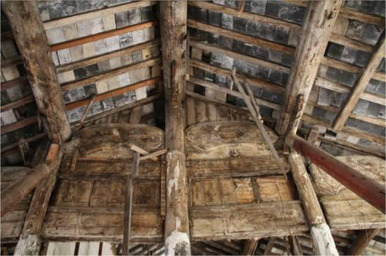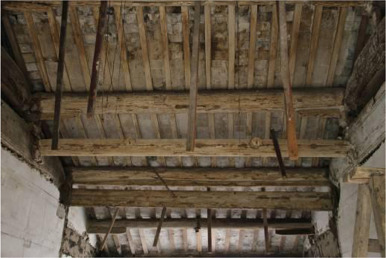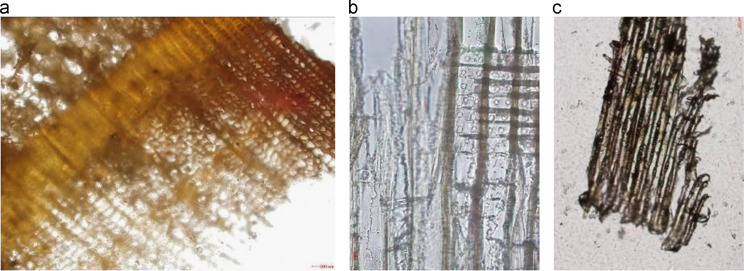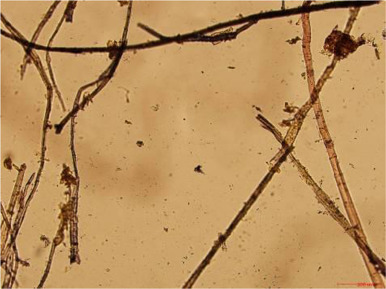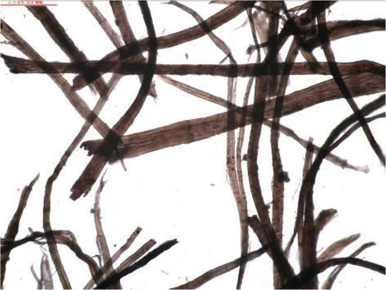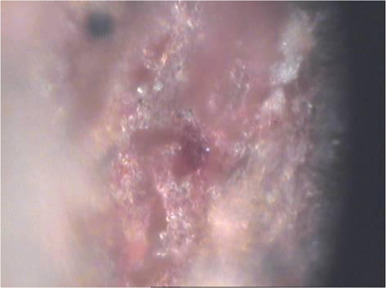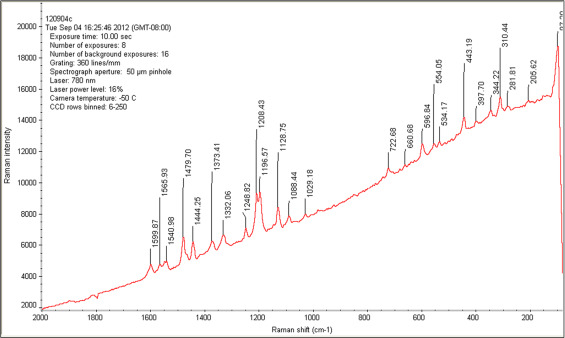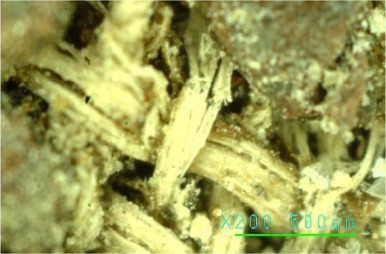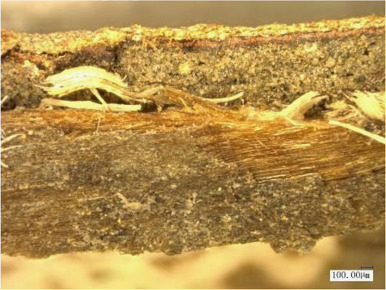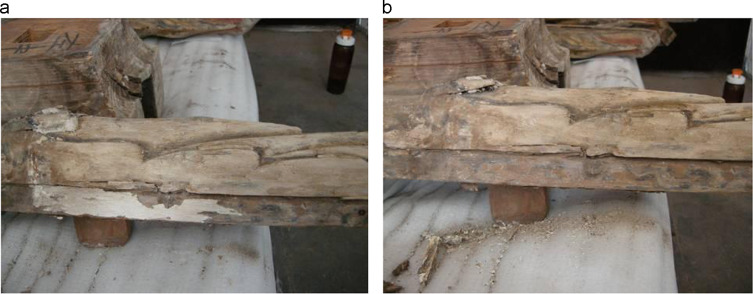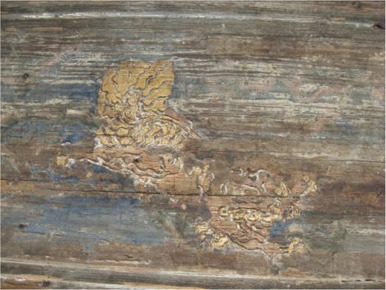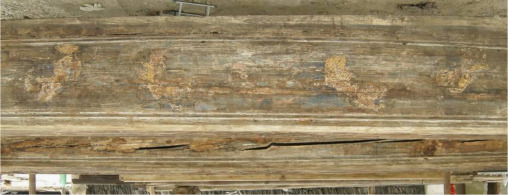Abstract
Xiaonan Garden is the back garden at the Weng family’s former residence, a famed mansion in Jiangnan. Various architectural colored paintings in the Jiangnan style, including a rare paster colored painting, are preserved in the garden. This study examines the wooden support, pigments, and structure of the painting and conducts a series of conservation experiments in situ and in the laboratory. Several conservation problems, such as the manually brushed lime, re-adherence of flaking painting layers, and consolidation of gold foil, were solved, and good results were obtained. Virtual recovery provided a solid foundation for protection and example of research on architectural colored paintings in Jiangnan.
Keywords
Architectural colored painting ; Conservation
1. Introduction
The former residence of the Weng family in Changshu exhibits the features of the mansion of a prestigious family that lived in Jiangnan, China during the Ming and Qing dynasties. The architectural colored painting preserved at Caiyi Hall, the main building, is a typical colored painting in Jiangnan. In December 1996, the former residence of the Weng family in Changshu was listed as one of the Fourth National Key Protected Cultural Relics.
Xiaonan Garden was constructed during the Ming Dynasty as the back garden of the former residence of the Weng family. “Xiaonanyuan” also called “Boguxuan” was a part of the Garden mansion in Changshu, which belonged to the celebrity “Sang” during the early Ming Dynasty. The place is named after the ancient cypress trees in the courtyard and also features a rock garden consisting of Taihu rocks. Wengtongjue, who was the third brother of Wengtonghe who lived during the Qing Dynasty, bought the mansion and resided in it. Wengtonghe and Wengkuisong, who was the grandson of Wengtongjue, also lived there. Subsequently, the mansion had a succession of owners and finally became part of the Weng family’s former residence. Connected to Caiyi Hall, Xiaonan Garden is the former residence of Yan Na (the minister of the Personnel Department and a scholar at Wuying Hall during the reign of Emperor Jiajing of the Ming Dynasty) and Yan Tianchi (son of Yan Na and founder of the Yushan Qin School). With its long history, Xiaonan Garden has been the residence of many noble families and famous persons and is valuable to Changshu and to the rest of China.
2. Condition survey
Xiaonan Garden was privately owned; thus, unknown to the public, the architectural colored paintings have been hidden by the sprung roof and brushed with lime. Through a survey, we discovered colored paintings in the Jiangnan style on the beam, column, tiebeam, and purlin. Delicate patterns, such as Ruyi and cirrus clouds, can be identified. The colors, including green, blue, black, white, yellow, and red, are elegant. The tone is gentle, presenting the delicate and exquisite style of the past. On the five beams rests a rare decorative pattern that shows four lions playing with a silk ball and created by dropping powder liquid and gilding.
Xiaonan Garden has been renovated many times. The architectural colored painting can be categorized into three types: colored painting with a yellowish brown bottom and pine-grain pattern, colored painting with a Jiangsu-style brocade cloth-wrapper pattern, and paster colored painting. The first two types overlap with the third one on top, indicating that the paster colored paintings were painted last. The coexistence of the three types is a prominent feature of Xiaonan Garden and has not been observed in other areas. Thus, the style deserves further research.
The investigation indicates that the style of the architectural colored painting in Xiaonan Garden differs from that at Caiyi Hall. In particular, the colored paintings on the beam and tiebeam fully display the diversity of the techniques used in Jiangnan (Fig. 1 ; Fig. 2 ).
|
|
|
Fig. 1. Heavily polluted surface. |
|
|
|
Fig. 2. Surface covered with lime. |
However, because Xiaonan Garden was historically used as a civil residence, the colored painting has been damaged by daily use and various natural factors. In many parts, the colored painting is flaked and damaged, and dust and dirt are found on its surface. The failure of conservation has compromised the intrinsic value of the colored painting.
3. Analysis and test
Through continuous investigation and scientific analysis, the traditional technique of the colored painting on an unplastered wooden surface has been summarized (He, 2009 ). Given the diversity and uniqueness of the colored painting in Xiaonan Garden, we need to conduct basic physical and chemical analyses of collected samples to identify the wood species used as the architectural component, the pigments used in the colored painting, and the ingredients of the paper, as well as to clarify the process used to provide basic information for the conservation of the colored paintings.
3.1. Identification of wood species used as architectural component
We take a piece of wood from the horizontal tiebeam on the east side as a sample for laboratory analysis. By analyzing the overall structure (the cross, tangential, and radial sections) of the wood and comparing it with the wood sample and microscopic section, we determine that the wood is Cunninghamia lanceolata of the Taxodiaceae family (Fig. 3 ).
|
|
|
Fig. 3. Micrograph of cross section (a), tangential (b), radial section (c). |
3.2. Identification of paper fiber
We obtain pieces of paper fiber from the margin of the damaged colored painting by using tweezers (Fig. 4 ). We separate and dye the pieces and then observe the paper fiber with a measuring instrument. The paper fiber is thin and long, with horizontal grain on the cross section. We conclude that the type of paper is bark paper.
|
|
|
Fig. 4. Micrograph of paper fibers. |
3.3. Identification of underlying fiber
Considering only the structural feature, we conclude that the fiber is ramie or hemp. Compared with hemp, the fiber is long, thick, and wide, with transverse rupture. We finally conclude that the underlying fiber is ramie (Fig. 5 ).
|
|
|
Fig. 5. Underlying fiber of colored painting. |
3.4. Analysis and Test of Pigment
After local cleaning, we analyze and test the pigment of the colored painting in the laboratory and discover seven primary colors: red, yellow, black, gold, blue, green, and white. Raman spectra results suggest that the white pigment is gypsum, the red pigment is vermilion (HgS), the yellow pigment is Tu Huang , the blue pigment is mineral green, and the black pigment is ink. The golden pigment is made of two kinds of gold foil. X-ray fluorescence analysis indicates that the yellow golden foil contains 92% gold and the red golden foil contains 75% gold.
Mainly natural mineral pigment, the pigment used in the colored painting in Xiaonan Garden is commonly applied in ancient Chinese architectural colored painting. However, a small amount of red plant pigment, which may be rouge, is discovered in the paster colored painting (Fig. 6 ; Fig. 7 ).
|
|
|
Fig. 6. Micrograph of red plant pigment. |
|
|
|
Fig. 7. Raman spectroscopy of red plant pigment. |
3.5. Analysis of lacquer and glue
To identify the glue in the pigment, we analyze and detect the pigment with a Fourier-transform infrared spectrometer. The absorption peak contains saturated aliphatic hydrocarbon. Inferring from records and traditional techniques, we presume that the glue is animal glue.
Red lacquer is used at the bottom of the paster colored painting. The Raman spectra indicate that the red pigment is vermilion. In addition, we analyze the lacquer with the Fourier-transform infrared spectrometer and find that the characteristic absorption peak contains Chinese lacquer and drying oil. We conclude that the red lacquer at the bottom should be a kind of Da Qi concocted from Chinese lacquer and tung oil.
3.6. Summary
The processes used in creating the three-colored paintings vary. In the colored painting with a yellowish brown bottom and pine-grain pattern, the wooden component is painted yellowish brown first and then with a pine-grain pattern. In the colored painting with a Jiangsu-style brocade cloth-wrapper pattern, the bottom is first painted white, and pigment and glue are then used (Fig. 8 ; Fig. 9 ).
|
|
|
Fig. 8. Micrograph of paster colored painting. |
|
|
|
Fig. 9. Cross Section of ultra-depth. |
The process used for the paster colored painting is complicated. Chinese lacquer is applied on the wooden component, the lacquer is smoothed when flax is glued, and the paster is painted red. Finally, pigments in various colors are used and gold foil is applied. The gold foils have varying amounts of gold content, which creates a decorative effect of different colors.
4. Conservation treatment
4.1. Laboratory and spot experiments
The architectural colored painting in Xiaonan Garden is poorly preserved and severely damaged; thus, the pigment layer on the surface is loose, and some pasters do not adhere to the colored painting and easily strip. Therefore, thorough conservation is needed to preserve the colored painting completely.
The conservation and renovation should also be based on the experiments conducted on the spot and in the laboratory.
4.1.1. Removal of Lime
Adhering tightly to the colored painting, the manually brushed lime on the surface is difficult to remove without destroying the paintings underneath. We conduct experiments on the damaged wooden component (with lime attached) to test the effect of removing lime with ethylenediaminetetraacetic acid (EDTA) with a density of 5% (made from distilled water), citric acid, oxalic acid, and sodium bicarbonate solution by using paster. The experiments show that the effect of EDTA with a density of 5% and citric acid is satisfactory, especially when they are used alternately, and that they can remove the lime that adheres to the surface.
In the in situ experiments, we alternately use EDTA with a density of 5% and citric acid, as well as the paster, which absorbs the lime on the wooden component. After the lime dissolves, we remove it carefully and successfully, thereby protecting the colored painting (Fig. 10) .
|
|
|
Fig. 10. Lime being removed (a) and after removed (b). |
4.1.2. Experiments on solidifying and smoothing of colored painting
We use protective and solidifying materials, such as B-72, polyvinyl acetate, epoxy, imported fluorine-containing epoxy, and glutin chitosan complex solution, to test their effects in the laboratory. Glutin chitosan complex solution has strong adhesion ability at low density and high permeability while maintaining the color (either becoming darker or brighter). Therefore, the solution meets the need to solidify and smooth the colored painting at Xiaonan Garden (Table 1 ).
| performance | Definition | ||||||||
|---|---|---|---|---|---|---|---|---|---|
| Film forming property | pH value | Strengthening feasibility | Pinhole after film-forming | Leveling property | Toxicity | Viscosity | Color | Gloss | |
| Carboxymethyl cellulose | Good | 6.5–8.0 | Ordinary | Nil | Ordinary | Nil | High | Transparent | Exist |
| Methyl cellulose | Good | 6.5–7.5 | Ordinary | Existing | Ordinary | Nil | High | Transparent | Exist |
| Ethyl cellulose | Good | 6.5–8.5 | Preferably | Nil | preferably | Nil | Moderate | Transparent | Nil |
| Hydroxypropyl methyl cellulose | Good | 7.0–8.0 | Preferably | Nil | Ordinary | Nil | Moderate | Transparent | Nil |
| Hydroxypropyl cellulose | Good | 5.0–8.5 | Preferably | Exist | Ordinary | Nil | High | Transparent | Exist |
| Hydroxyethyl cellulose | Good | 6.0–8.5 | Preferably | Nil | Bad | Nil | High | Transparent | Exist |
| Xanthan gum | Good | 7.0 | Preferably | Exist | Ordinary | Nil | High | Slight white | Nil |
| Propolis | Ordinary | 4.0–6.0 | Ordinary | Nil | Preferably | Nil | Ordinary | Yellowish | Nil |
| Water-soluble propolis | Ordinary | 4.0–6.0 | Ordinary | Nil | Preferably | Nil | Ordinary | brown | Nil |
| Decolored gelatin | Good | 6.5–7.5 | Preferably | Nil | Good | Nil | Moderate | Yellowish | Nil |
| Soluble chitosan | Good | 5.0–7.0 | Preferably | Exist | Good | Nil | Moderate | Slight white | Nil |
| Chitosan | Good | 7.0–9.0 | Preferably | Exist | Good | Nil | Moderate | Slight white | Nil |
| Bone glue | Good | 6.5–7.5 | Preferably | Nil | Good | Nil | Moderate | Yellowish | Nil |
| Hide glue | Good | 6.5–7.5 | Preferably | Nil | Good | Nil | Moderate | Yellowish | Nil |
| Lacquer glue | Ordinary | 6.0–8.0 | Ordinary | Nil | Good | Nil | Ordinary | Light red | Nil |
| Arabic gum | Good | 6.5–7.5 | Ordinary | Exist | Ordinary | Nil | High | Transparent | Exist |
Based on specific tests, we conclude that the glutin chitosan complex solution with 5% solid and chitosan with a density of 0.1% fully permeates into the colored painting and produces the adhesion required by solidifying and smoothing the colored painting.
4.1.3. Conservation on the spot
After the investigation, test, and analysis conducted on the spot, we establish measures to protect the architectural colored painting based on small-scale tests in the laboratory and garden: dust cleaning, removal of the dirt layer (e.g., lime), pre-solidification and protection, careful protection and treatment (i.e., after paste removal), local repair, and sealing.
- Cleaning the colored painting
Much dust is deposited on the surface of the colored painting. In the spot test, we find that a soft pen can be used to remove the dust. Given the fragility of the painting, we gently operate to avoid breaking the already ruptured painting. Before cleaning, we first determine whether the painting layer is stable or well preserved. In cleaning the dirt, we follow the principle of “physical treatment first and chemical treatment second.” Given that the plaster colored painting is produced in a special process and the glue severely strips, several methods are used together.
- Pre-solidification
Pre-solidification is conducted to facilitate the cleaning of the fragile ash and dirt on the surface. The solidifier is sprayed to wet the surface. Before the solidifier dries, we use Xuan paper to absorb the dirt that adheres to the solidifier.
A degreasing cotton ball or neutral cleaning solution from distilled water is then used to wipe the residual dust and dirt layer. Finally, we use distilled water to clean the surface and ensure that no cleaning solution remains on the surface.
- Solidifying and smoothing the colored painting
We add potassium sorbate and a water-soluble UV absorber to the water-soluble chitosan and bleaching gelatin. The solidifier has strong permeability and adhesion at low density. Potassium sorbate also enhances the ability of the solidifier to resist aging and bacteria.
We configure the 5% gelatin aqueous solution with distilled water and then add 1‰ water-soluble chitosan to decolorize it and form a supernatant. We then heat the supernatant to 80 °C. We add 1‰ water-soluble chitosan to form a blend solution, stir it for 30 min to filter the solidifier solution, and then add 0.5% potassium sorbate to the solidifier solution to dissolve it. Subsequently, we add 0.3–0.5% water-soluble UV absorber and stir to dissolve it. When the pH remains neutral or reaches 6.5–7.5 and the temperature remains at 30 °C, the solidifier forms.
We spray the solidifier first and brush again when the solidifier dries. For deep solidification, injection is used, so that the solidifier can flow deep and achieve a satisfactory effect. We do not press the surface because the pigment layer on the surface is soft. When the solidifier solution totally diffuses into the pigment and paper (i.e., after 5 min), we brush the curved paper at the opposite side or inject the solidifier and then use a horn-shaped tool to press slightly and smooth the curved part.
We check the colored painting after three days. We inject the solidifier solution into the local areas of the curved parts until they become smooth. After one week, we check the effect by flapping the colored painting.
The process of dropping powder liquid and gilding is similar to solidification, meets the requirements of the protection of cultural relics, and achieves the desired effect. Given the fragility of the colored painting, overall solidification should be considered the main method, and local solidification and injection the alternative choices.
- Sealing
To avoid erosion by contaminants or water, we seal the surface of the colored painting in a chemical manner. The sealing layer can optimally retain the original appearance of the colored painting. It can also prevent air and humidity from further damaging the colored painting.
The sealing material we choose is Parliker, a professional material imported from France and used to protect cultural relics. Compared with similar foreign products, it is used for the protection of the old city of the Vatican and is also approved and adopted broadly by the Agency of historical relic preservations in France, Germany, and Belgium. The final product of Parliker is SiO2 , which does not affect the pigment layer and future treatment. Parliker is an ideal sealing material because it can be reproduced. Parliker has been used for eight years as sealing material to protect the architectural colored painting in Zhao Yongxian’s residence. The surface of this colored painting remains intact (Fig. 11 ).
|
|
|
Fig. 11. Four Lions Playing with Silk Ball after dropping the powder liquid and gilding (local treatment). |
5. Local simulation and recovery
The original appearance of severely damaged colored paintings should be retained, but repair cannot be conducted if reliable evidence cannot be found. Thus, virtual (computer) repair should be used.
The colored painting in Xiaonan Garden has been severely destroyed. For the lost part, we use an infrared camera to obtain an infrared photo but find no damage. Thus, we conduct a typological analysis of the colored painting. Based on similar and symmetrical patterns in the painting, we use a computer to complete the image by determining the pattern of the representative pictures. In virtual recovery, a basic principle is to represent to the maximum extent possible the information and unique charm of the colored painting without resorting to groundless fabrication. The virtual recovery of Four Lions Playing with Silk Ball is described below ( Fig. 12 , Fig. 13 , Fig. 14 , Fig. 15 ; Fig. 16 ).
|
|
|
Fig. 12. Four Lions Playing with Silk Ball before virtual recovery. |
|
|
|
Fig. 13. Original appearance of Four Lions Playing with Silk Ball . |
|
|
|
Fig. 14. Details of Four Lions Playing with Silk Ball. |
|
|
|
Fig. 15. Patterns of the Four Lions after virtual recovery. |
|
|
|
Fig. 16. Four Lions Playing with Silk Ball after virtual recovery. |
6. Results and conclusion
Jiangnan boasts of a long history of producing and using raw lacquer. Historical records and relics confirm that Chinese lacquer has been used as the bottom layer of architectural colored paintings. Chinese lacquer is generally used to make golden glaze. Oil painting has replaced Chinese lacquer in the Yunnan Province during the Qing Dynasty (He, 2010 ).
Similar to hemp in northern China, ramie (Xia Bu in areas south of the Yangtze River) is widely used to solidify the underlying layer of architectural colored paintings. However, no reliable record or evidence shows that flax is placed at the bottom and that Chinese lacquer is used to glue the paper, in contrast to the Di Zhang in northern China and the lacquer paint in Jiangnan.
Bark paper is used in paster colored painting. Before painting, a layer of white powder is brushed. Bark paper has been used since the Song Dynasty. In “Sha Qing” Tian Gong Kai Wu , the methods of using different kinds of bark paper are introduced. The bark paper used in the colored painting of Xiaonan Garden is pure bark paper, with no bamboo hemp or grass. Pure bark paper has three advantages: First, it is thick and tough. Second, it does not become deformed. As Tian Gong Kai Wu indicates, the bark paper used in painting does not become deformed when soaked in alum solution ( Song ). Third, its bottom cannot be dyed using red Chinese lacquer. However, pure bark paper increases the acidity of the colored painting of Xiaonan Garden, thereby damaging it and reducing its durability.
The method used in the colored painting in Xiaonan Garden embodies local features and the combination of many techniques in architectural colored painting. Lacquer work is used in colored painting, including in colored painting with red and black gold foils and with raden and mica encased in the lacquer surface. In Baolun Pavilion (Anhui Province), Chinese lacquer is painted on the wooden partition. In Chuman Pavilion, colored painting is found on paper. In the residence of the Cheng family, paperhanging is found on the wooden table, similar to present-day mural paintings. Thus, the birth of such methods as using Chinese lacquer and gold foil in colored painting is easy to understand.
In summary, through the investigation and protection of the colored painting in Xiaonan Garden, we clarify the process of and identify difficulties in preservation using several tests, which lay the foundation for the conservation of colored paintings. The solidifying material and virtual recovery provide valuable examples of protecting architectural colored paintings in other areas.
The plaster colored painting in Xiaonan Garden not only confirms the use of Chinese lacquer and paper in Jiangnan but also provides material for the study of the colored painting in the former residence of the Weng Family. This painting enriches the historical, artistic, and scientific value of the residence and provides a valuable cultural heritage for the study of the processes used in architectural colored paintings in Jiangnan.
Acknowlegments
This project is supported by the State Key Program of National Natural Science of China (No. 6501000027): Theory and method of the adaptive protection and utilization of urban architectural heritage in China.
References
- HE Weijun, 2009 He Weijun; Traditional technique of colored painting on unplastered wooden surface of ancient architectures in Jiangsu; Southeast Cult., 5 (2009), pp. 101–107
- HE Weijun, 2010 He Weijun; A preliminary study of the process of bai nationality architectural colored painting in Dali, Yunnan province; Study Chin. Cult. Relics, 4 (2010), pp. 36–39
- SONG et al., Song Yingxing. Sha Qing. Tian Gong Kai Wu. Vol 13.
Document information
Published on 12/05/17
Submitted on 12/05/17
Licence: Other
Share this document
Keywords
claim authorship
Are you one of the authors of this document?
